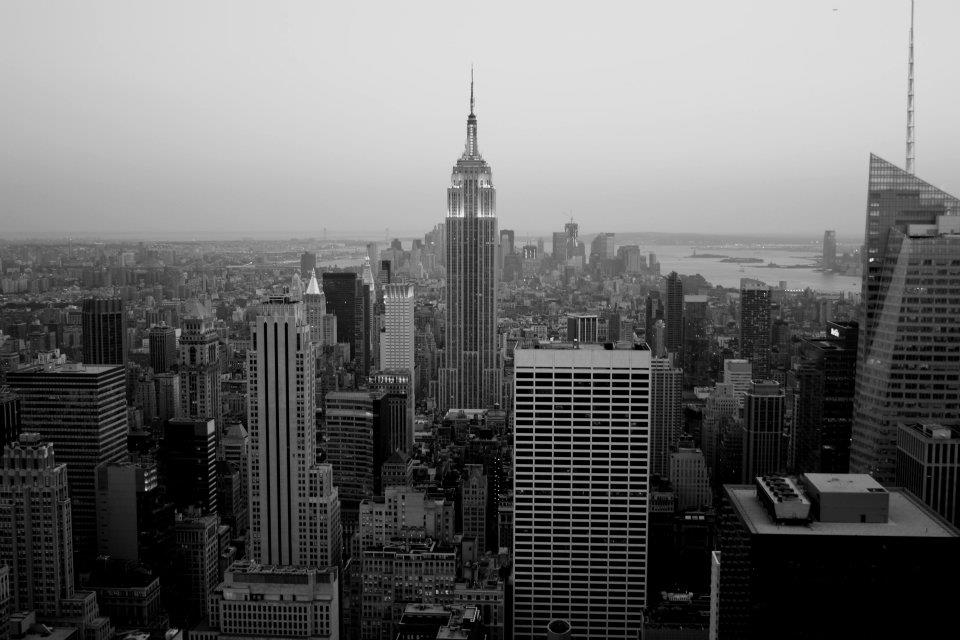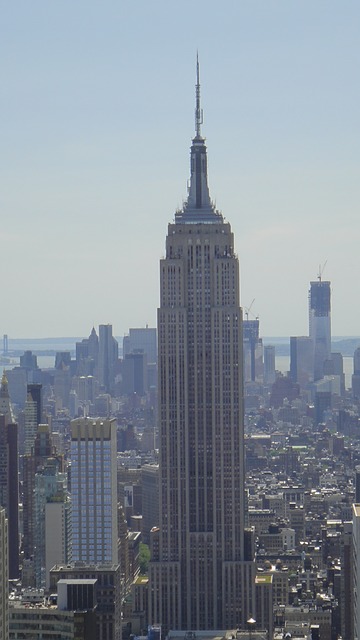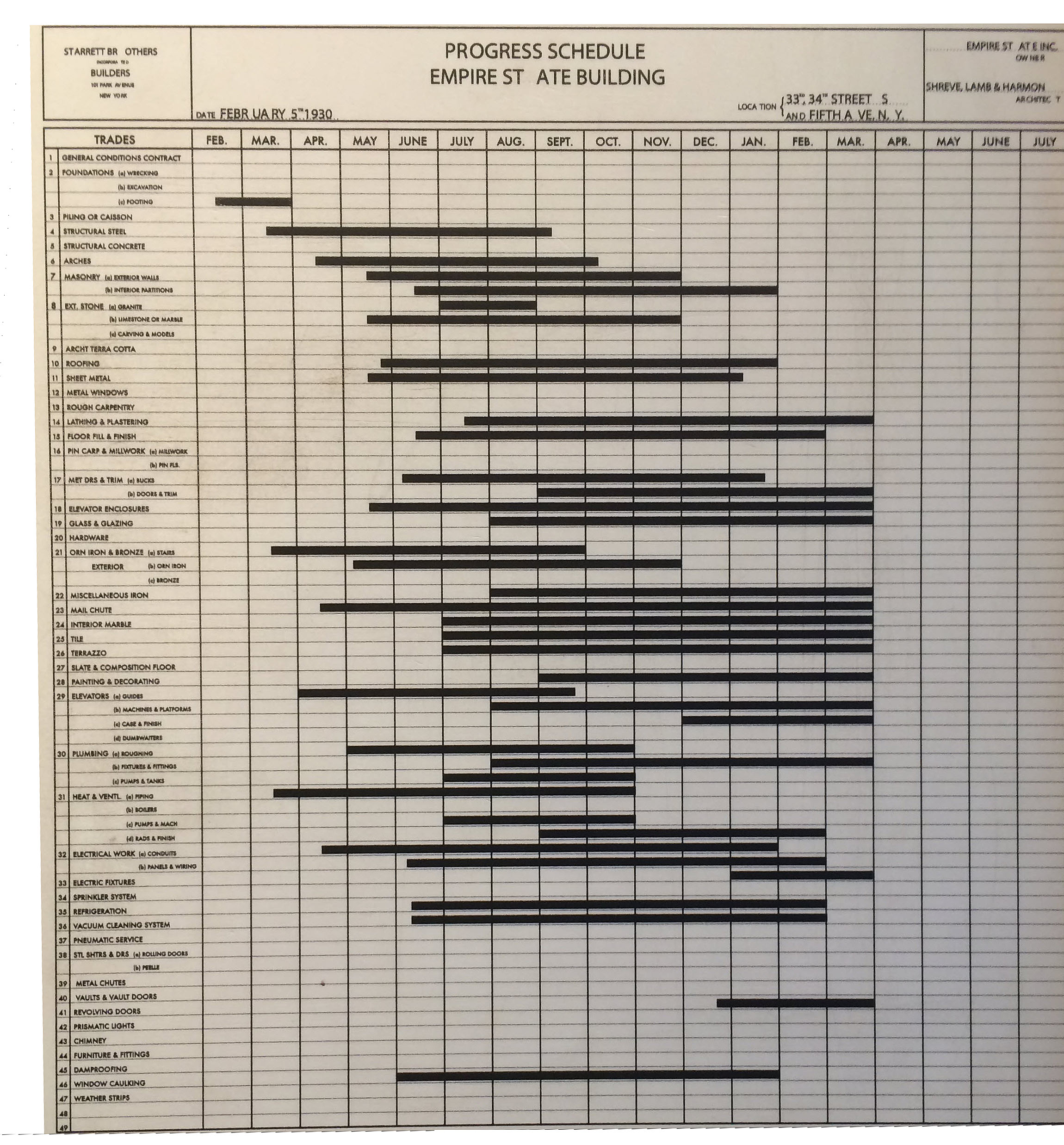Empire State Building, New York
See the rest of the Building of the Week series here.
Contents |
[edit] Introduction
The Empire State Building, in Midtown Manhattan, New York City, is one of the most iconic skyscrapers in the world. Standing at 381 m tall, (total height with spire - 443 m), it held the title of world’s tallest building from 1931 to 1971, and today remains the fourth-tallest building in the United States.
It is particularly distinctive for its art deco design, typical of pre-World War II architecture in New York, together with a series of steps in its profile that cause it to taper with height.
As a cultural icon, the Empire State Building has been featured in numerous works of film, TV and art, and was named one of the seven wonders of the modern world by the American Society of Civil Engineers.
[edit] Design and construction
Legend has it that the building originated from a competition between Walter Chrysler of the Chrysler Corporation and John Jakob Raskob of General Motors to see who could build the tallest skyscraper. Chrysler began work on the Chrysler Building in Midtown Manhattan, and so Raskob chose the architecture firm Shreve, Lamb and Harmon Associates to design a building that would surpass it.
The design was said to have been based on a pencil, with 85 storeys of commercial and office space. The 86th floor houses an indoor and outdoor observation deck, and the 16 storeys above form the art deco tower, topped by an observatory on the 102nd floor. It was the first building in the world to exceed 100 floors. The building has a total of 73 elevators located in a central core. The spire was added to ensure its total height was greater than the Chrysler Building and this was later converted into a broadcast tower for TV and radio.
It was built using a hot riveted steel frame. This means the joints are stronger than any weld or bolt, as the hot rivets apply pressure between the two surfaces.
 The building is also notable for its very swift construction; the entire structure took less than 14 months to build. At any one time the project employed up to 3,400 workers which was seen as a proud symbol of productivity in the midst of the Great Depression.
The building is also notable for its very swift construction; the entire structure took less than 14 months to build. At any one time the project employed up to 3,400 workers which was seen as a proud symbol of productivity in the midst of the Great Depression.
It was also one of the first construction projects to use Gantt charts for planning:
[edit] Post-completion
The building was officially opened on 1st May 1931 by President Herbert Hoover. Despite its recognition as an an architectural triumph, the building’s rentable space remained largely empty for several years, which led to New Yorkers dubbing it the ‘Empty State Building’. It was only in 1950, as the United States began to experience renewed economic prosperity, that the building became profitable.
In 1945, the building was hit by a B-25 bomber plane in heavy fog, which caused a fire and killed 14 people.
Culturally, the building is an icon, largely as a result of its appearance in the 1933 film ‘King Kong’ in which the eponymous ape scales the building whilst being attacked by fighter planes.
In 1965, floodlights were added and the spire is illuminated regularly on special occasions.
In 2009, a $106 million energy efficiency retrofit project began, which succeeded in transforming the building into one of the most sustainable in the world. The retrofit included upgrades to mechanical electrical and plumbing (MEP) systems and the replacement of all 6,514 windows with units that have 400% more thermal efficiency than normal dual pane windows. In 2011 it became the tallest building to be awarded a gold Leadership in Energy and Environmental Design (LEED) rating certificate.
Today, the Empire State Building remains a popular tourist attraction, with 360-degree views of Manhattan from the 86th floor observation deck.
[edit] Project data
- Address: 350 5th Avenue, Manhattan, New York City, USA
- Construction started: 1930
- Completed: 1931
- Height: 443.2 m
- Floors: 103
- Floor area: 208,879 m2
- Architect: Shreve, Lamb and Harmon
- Main contractor: Starrett Brothers and Eken
- Construction cost: $40,948,900
- Owner: Empire State Realty Trust
[edit] Related articles on Designing Buildings Wiki
- 7 Engineering Wonders of the world.
- 9 of the world’s most impressive structures.
- Art Deco.
- Building of the week series.
- Buildings in film.
- Citigroup Center.
- CN Tower.
- Flatiron Building.
- Leadership in Energy and Environmental Design.
- New York Horizon.
- Nexus.
- One World Trade Center.
- Petronas Twin Towers.
- PWA Moderne.
- Rockefeller Center.
- Shanghai Tower.
- Skyscraper.
- Tallest buildings in the world.
- The Gherkin.
- The history of fabric structures.
- The Shard.
- Trump Tower New York.
[edit] External references
- Empire State Building - Official site
- Skyscraper Center - Empire State Building
Featured articles and news
Professional practical experience for Architects in training
The long process to transform the nature of education and professional practical experience in the Architecture profession following recent reports.
A people-first approach to retrofit
Moving away from the destructive paradigm of fabric-first.
International Electrician Day, 10 June 2025
Celebrating the role of electrical engineers from André-Marie Amperè, today and for the future.
New guide for clients launched at Houses of Parliament
'There has never been a more important time for clients to step up and ...ask the right questions'
The impact of recycled slate tiles
Innovation across the decades.
EPC changes for existing buildings
Changes and their context as the new RdSAP methodology comes into use from 15 June.
Skills England publishes Sector skills needs assessments
Priority areas relating to the built environment highlighted and described in brief.
BSRIA HVAC Market Watch - May 2025 Edition
Heat Pump Market Outlook: Policy, Performance & Refrigerant Trends for 2025–2028.
Committing to EDI in construction with CIOB
Built Environment professional bodies deepen commitment to EDI with two new signatories: CIAT and CICES.
Government Grenfell progress report at a glance
Line by line recomendation overview, with links to more details.
An engaging and lively review of his professional life.
Sustainable heating for listed buildings
A problem that needs to be approached intelligently.
50th Golden anniversary ECA Edmundson apprentice award
Deadline for entries has been extended to Friday 27 June, so don't miss out!
CIAT at the London Festival of Architecture
Designing for Everyone: Breaking Barriers in Inclusive Architecture.
Mixed reactions to apprenticeship and skills reform 2025
A 'welcome shift' for some and a 'backwards step' for others.























